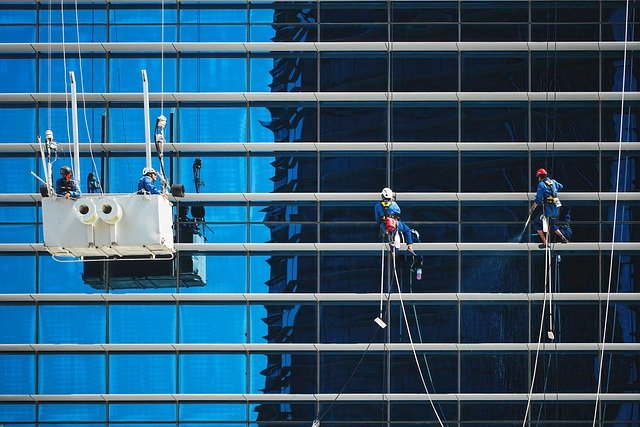Uncovering the Future of Maintenance: Drones That Clean Glass Like Pros
High-rise buildings and large glass structures have always presented maintenance challenges. Traditional methods require scaffolding, lifts, and significant manpower. Now, drone technology is revolutionizing how we approach glass cleaning, offering innovative solutions that combine efficiency with safety. This emerging field is reshaping maintenance practices across industries, from urban skyscrapers to renewable energy installations.

The maintenance industry is experiencing a technological revolution, and drone-based glass cleaning stands at the forefront of this transformation. For decades, cleaning windows on tall buildings meant deploying workers on suspended platforms or using expensive crane systems. These methods not only posed safety risks but also required extensive setup time and labor. Today, specialized drones equipped with cleaning mechanisms are changing the landscape, offering a glimpse into a future where maintenance becomes faster, safer, and more cost-effective.
Drone technology has advanced rapidly, with manufacturers developing units specifically designed for surface cleaning. These machines combine flight stability systems, high-pressure water jets, rotating brushes, and specialized cleaning solutions. Some models use ultrasonic technology or microfiber attachments to remove dirt without chemicals. The integration of artificial intelligence allows drones to map building facades, identify dirty areas, and execute cleaning patterns autonomously. This level of sophistication was unimaginable just a few years ago.
What Makes Drone-Based Cleaning Safer and Faster Than Ever
Safety improvements represent one of the most compelling advantages of drone-based cleaning systems. Traditional window cleaning on high-rise buildings involves significant risks, with workers suspended at dangerous heights. Human error, equipment failure, or adverse weather conditions can lead to serious accidents. Drones eliminate the need for human workers to operate at elevation, drastically reducing injury risks.
Speed is another major benefit. A drone can reach any height within seconds, while traditional methods require time-consuming setup of scaffolding or lift systems. Drones equipped with multiple cleaning heads can cover large surface areas quickly, often completing jobs in a fraction of the time required by conventional crews. Advanced models can operate continuously for extended periods, with battery swap systems enabling near-constant operation. The ability to work in conditions that might ground human workers, such as moderate wind or light rain, further enhances productivity.
Remote operation capabilities mean that a single operator can control multiple drones from a safe location. This multiplies efficiency while maintaining oversight. Real-time video feeds allow operators to monitor cleaning quality and adjust techniques as needed. GPS and sensor technology ensure precise positioning, preventing collisions with building features while maintaining optimal cleaning distance from glass surfaces.
How Technology Is Transforming High-Rise Maintenance
The transformation extends beyond just cleaning. Drones equipped with high-resolution cameras and sensors now perform building inspections simultaneously with cleaning operations. They can detect cracks, structural issues, or seal degradation that might otherwise go unnoticed until major problems develop. This dual functionality provides building managers with comprehensive maintenance data.
Data analytics platforms process information collected by drones, creating maintenance schedules based on actual building conditions rather than arbitrary timelines. Machine learning algorithms predict when specific areas will require attention, optimizing resource allocation. Building management systems integrate drone data, providing facility managers with centralized dashboards showing real-time building conditions.
Environmental considerations are driving adoption as well. Modern cleaning drones use significantly less water than traditional methods, with some systems recycling and filtering water during operation. Reduced chemical usage minimizes environmental impact, while electric propulsion systems eliminate emissions associated with diesel-powered lifts and generators. The smaller carbon footprint aligns with corporate sustainability goals and green building certifications.
From Skyscrapers to Solar Panels — Where This Tech Is Headed Next
While urban high-rises represent the most visible application, drone cleaning technology is expanding into diverse sectors. Solar panel maintenance has emerged as a major growth area. Dust, pollen, and debris accumulation can reduce solar panel efficiency by 20 to 30 percent. Large solar farms covering hundreds of acres make manual cleaning impractical. Drones equipped with soft brushes and deionized water systems can clean thousands of panels daily without scratching delicate surfaces.
Greenhouse operations are adopting drone cleaning for glass roofs and walls. Agricultural facilities require consistent light transmission for optimal plant growth, but accessing greenhouse roofs for cleaning is challenging. Drones provide a solution that maintains light levels without disrupting operations or risking damage to structures.
Transportation infrastructure presents another frontier. Airport terminals, train stations, and large public buildings with extensive glass facades benefit from drone maintenance. Sports stadiums with retractable roofs or large glass sections are exploring these systems. Even residential applications are emerging, with smaller drones designed for home use appearing on the market.
The technology continues evolving. Researchers are developing drones that can clean vertical surfaces using magnetic or suction attachment systems, eliminating the need for constant flight and extending operational time. Swarm technology, where multiple drones coordinate automatically to clean large areas, is moving from experimental to practical deployment.
Challenges and Considerations
Despite advantages, challenges remain. Regulatory frameworks are still developing, with aviation authorities establishing rules for commercial drone operations near buildings and populated areas. Operators must obtain proper licensing and follow airspace restrictions. Weather limitations persist, as high winds, heavy rain, or extreme temperatures can ground operations.
Initial investment costs can be substantial. Professional-grade cleaning drones range from several thousand to tens of thousands of dollars, depending on capabilities. Training requirements for operators add to implementation costs. However, these expenses often offset quickly through reduced labor costs and increased efficiency.
Technical limitations include battery life, payload capacity, and the need for water supply connections. Current models typically operate for 20 to 40 minutes before requiring battery changes. Tethered systems that provide continuous power are addressing this limitation but reduce mobility.
The Path Forward
The trajectory for drone-based cleaning technology points toward increased automation and capability. As artificial intelligence improves, drones will require less human oversight, potentially operating entirely autonomously for routine maintenance. Integration with smart building systems will enable predictive maintenance, with drones automatically deploying when sensors detect cleaning needs.
Cost reductions through mass production and technological maturation will make systems accessible to smaller operations. Standardization of equipment and procedures will simplify adoption and training. As success stories accumulate and safety records strengthen, regulatory acceptance will likely increase, easing operational restrictions.
The convergence of robotics, artificial intelligence, and drone technology is creating maintenance solutions that seemed like science fiction a generation ago. While human expertise remains essential for complex situations and oversight, drones are proving themselves as valuable tools that enhance safety, efficiency, and effectiveness. The future of building maintenance is taking flight, and the view from this new perspective is remarkably clear.




